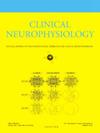新生儿脑电图高频振荡及其与癫痫的关系。
IF 3.6
3区 医学
Q1 CLINICAL NEUROLOGY
引用次数: 0
摘要
目的:我们评估了新生儿脑电图中的高频振荡(HFOs):我们对新生儿脑电图中的高频振荡(HFOs)进行了评估,假设高频振荡将在癫痫盛行或即将发生严重癫痫的新生儿中普遍存在,在良性癫痫或急性诱发癫痫发作的新生儿中较少,而在健康新生儿中则不存在:我们从人群脑电图数据库中识别了患有新生儿癫痫、慢性脑部疾病、急性中风、围产期缺氧缺血性脑病、急性脑部感染或无神经系统诊断的新生儿。我们对睡眠阶段、癫痫发作和 HFOs 进行了人工标记,并根据病历对结果进行了评估:29/98(30%)名新生儿检测到 HFO,其中 10 名为发作性 HFO(中位数为 0.53 次/分钟,范围为 0.07-6.41 次/分钟),24 名为非发作性 HFO(中位数为 0.20 次/分钟,范围为 0.01-20.99 次/分钟)。非发作性 HFO 的发生率和发生率在 i)新生儿期发病的发育性和癫痫性脑病(DEE)新生儿中明显高于大多数其他诊断组别;ii)在后来发展为婴儿期发病的 DEE 的新生儿中明显高于其他诊断组别(P 结论:新生儿非发作性 HFO 的发生率和发生率明显高于其他诊断组别(P 结论:新生儿非发作性 HFO 的发生率和发生率明显高于其他诊断组别):新生儿非发作性 HFO 与当时或即将发生的早发性 DEE 有关:我们的数据支持以下假设:新生儿头皮HFOs i)是病态的,ii)与癫痫严重程度相关,iii)是癫痫发生的标志物。本文章由计算机程序翻译,如有差异,请以英文原文为准。
High-frequency oscillations in neonatal EEG and their association with epilepsy
Objective
We assessed high-frequency oscillations (HFOs) in neonatal EEG hypothesizing that HFOs would be prevalent in neonates with prevailing or forthcoming severe epilepsy, fewer in those with benign epilepsy or acute provoked seizures, and absent in healthy neonates.
Methods
From a population-derived EEG database, we identified neonates with neonatal-onset epilepsy, chronic brain disease, acute stroke, perinatal hypoxic ischemic encephalopathy, acute brain infection, or no neurological diagnoses. We marked sleep stages, seizures, and HFOs manually, and evaluated outcome from medical records.
Results
HFOs were detected in 29/98 (30 %) neonates, of whom 10 had ictal (median rate 0.53/min, range 0.07–6.41/min) and 24 had nonictal HFOs (median rate 0.20/min, range 0.01–20.99/min). Nonictal HFO occurrence and rate were significantly i) higher in neonates with neonatal-onset developmental and epileptic encephalopathy (DEE) than most other diagnostic groups, and ii) higher in neonates that later developed infantile-onset DEE (p < 0.05) than those surviving without DEE. Ictal HFOs were common during acute provoked seizures and were not linked with epilepsy.
Conclusions
Neonatal nonictal HFOs were associated with prevailing or forthcoming early-onset DEE.
Significance
Our data support the hypotheses that neonatal scalp HFOs are i) pathological, ii) associated with epilepsy severity, and iii) a marker of epileptogenesis.
求助全文
通过发布文献求助,成功后即可免费获取论文全文。
去求助
来源期刊

Clinical Neurophysiology
医学-临床神经学
CiteScore
8.70
自引率
6.40%
发文量
932
审稿时长
59 days
期刊介绍:
As of January 1999, The journal Electroencephalography and Clinical Neurophysiology, and its two sections Electromyography and Motor Control and Evoked Potentials have amalgamated to become this journal - Clinical Neurophysiology.
Clinical Neurophysiology is the official journal of the International Federation of Clinical Neurophysiology, the Brazilian Society of Clinical Neurophysiology, the Czech Society of Clinical Neurophysiology, the Italian Clinical Neurophysiology Society and the International Society of Intraoperative Neurophysiology.The journal is dedicated to fostering research and disseminating information on all aspects of both normal and abnormal functioning of the nervous system. The key aim of the publication is to disseminate scholarly reports on the pathophysiology underlying diseases of the central and peripheral nervous system of human patients. Clinical trials that use neurophysiological measures to document change are encouraged, as are manuscripts reporting data on integrated neuroimaging of central nervous function including, but not limited to, functional MRI, MEG, EEG, PET and other neuroimaging modalities.
 求助内容:
求助内容: 应助结果提醒方式:
应助结果提醒方式:


